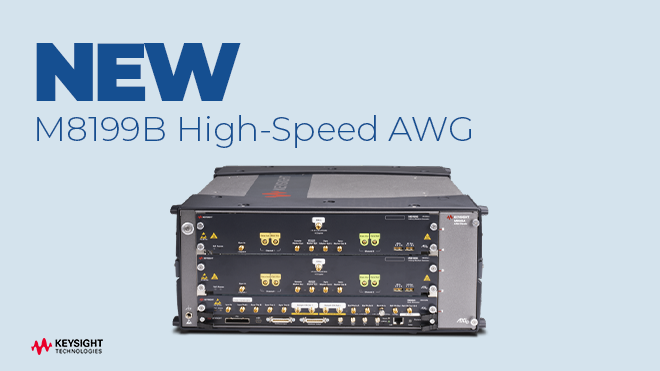NEW M8199B High-Speed AWG – Keysight’s highest performing AWG yet!
The Keysight M8199B arbitrary waveform generator (AWG) has the highest sample rate and the widest bandwidth in its class with up to eight synchronized channels operating simultaneously.
Check it out!
- Analog bandwidth exceeding 80 GHz
- Up to 2 Vpp differential output voltage at 160 GBaud
- Continuous sample rate range: 200 to 256 GSa/s
- Channel-to-channel skew adjustment with 25 fs resolution
- < 140 dBc wideband phase noise > 1 MHz
- 1 MSa of waveform memory per channel
- Synchronization of up to 8 channels across 4 modules
- Built-in frequency and phase response calibration for clean output signals
What makes the M8199B better?
The M8199B gives you the speed, bandwidth, precision, and flexibility to meet the challenges of next-generation applications, including >400 Gb/s per lane in intensity-modulation/direct-detect (IM/DD) and >1.6 Tb/s per carrier in coherent optical communications.
- Up to 8 synchronized channels at 256 GSa/s with nominal analog bandwidth exceeding 80 GHz
- Provides R&D engineers a high-performance signal source for arbitrary signals, enabling development of designs of higher-order QAM (e.g., 64QAM) at 160 GBaud and above
- First arbitrary waveform generator enabling 400+ Gb/s per lane in IM/DD or 1.6+ Tb/s per carrier in coherent optical communications
- Integrated, ready-to-use instrument, works with M8008A clock module
- Operates with well-known software, including MATLAB, Keysight IQtools, and SCPI programming interfaced based on M8070B
Why Upgrade?
- Receive up to a 30% trade-in credit towards the purchase of a new M8199B Arbitrary Waveform Generator (offer through June 30, 2023).
- Upgrade your existing products to a high-performance signal source for arbitrary signals, enabling development of designs of 160 GBd and above.
- Get the highest-performing AWG with 256 GSa/s, increased bandwidth and amplitude, and improved signal-to-noise (SNR) ratio.

